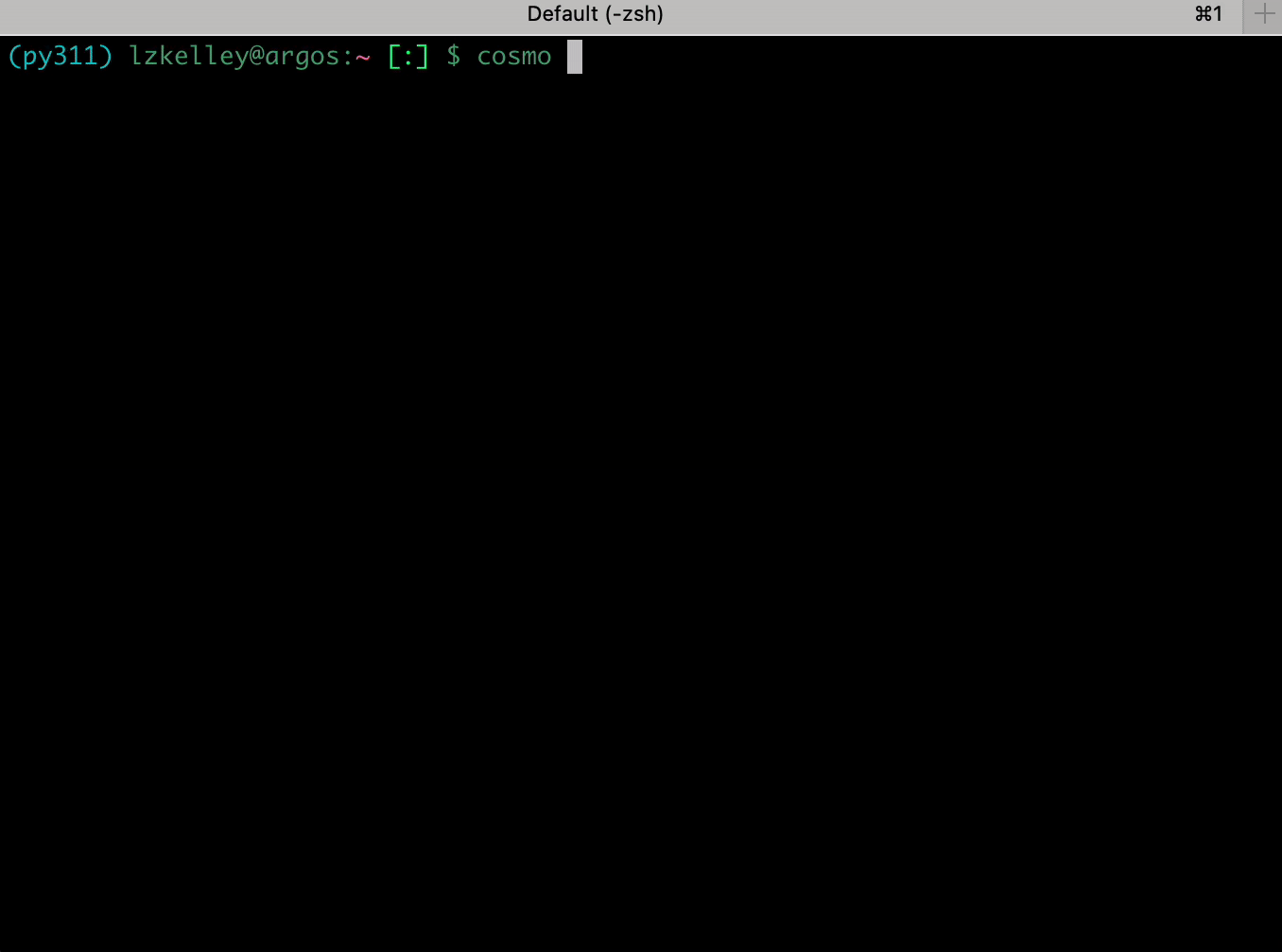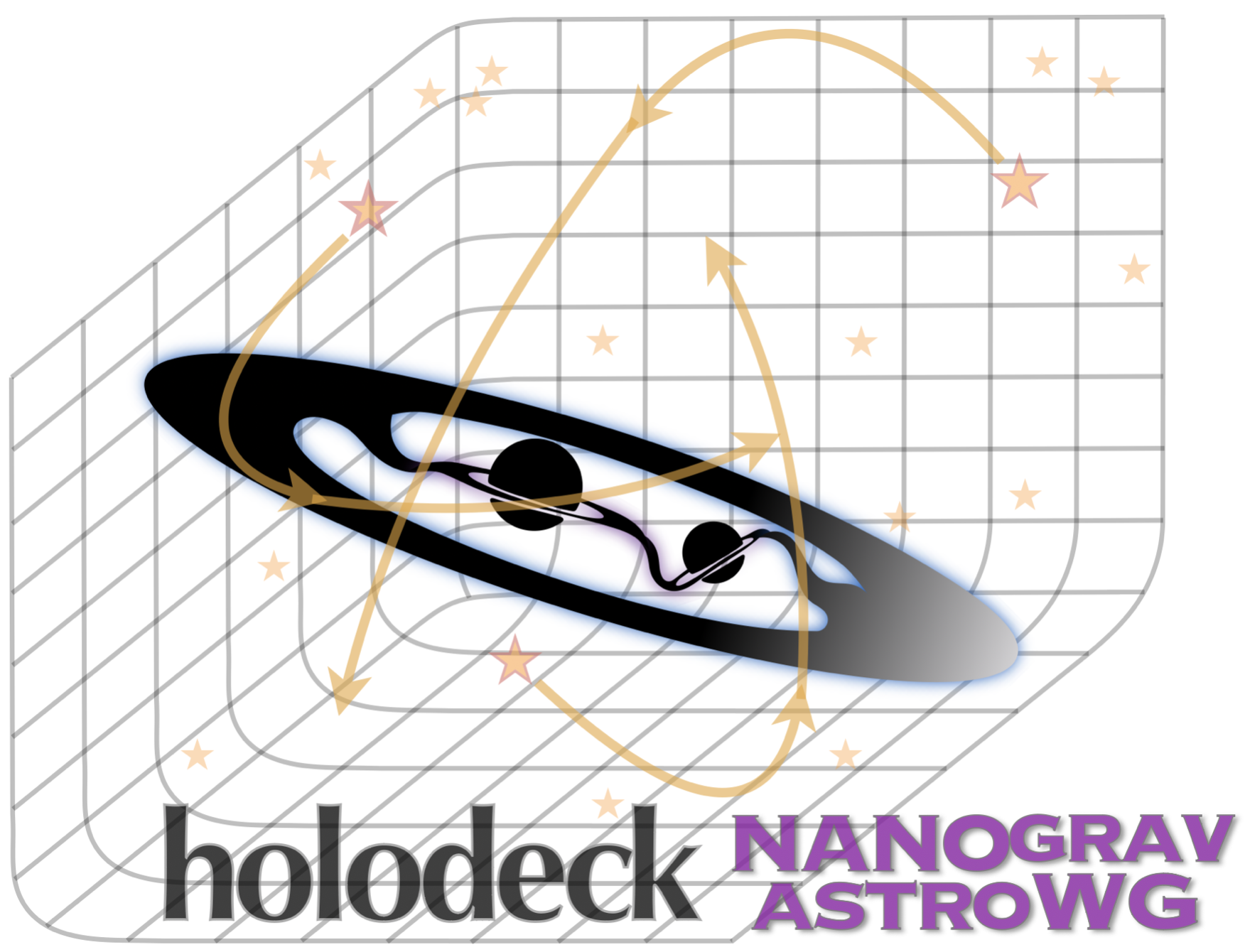Resources
Software Tools
cosmopy (GitHub)
Command-line tool and simple python library for cosmological calculations.
From the command-line, cosmopy will quickly print cosmological distance measures, for example: converting from redshift to luminosity distance, lookback time, etc.

As a python library, cosmopy is a simple wrapper around the astropy.Cosmology class that speeds up the calculation of distance measures by precomputing them over a grid, and then rapidly interpolating, instead of re-integrating each time a new distance measure is requested which is the default behavior with astropy.
holodeck (GitHub)

Framework for massive black-hole binary population synthesis. holodeck is a python package developed by the NANOGrav Astrophysics Working Group to simulate populations of massive black-hole (MBH) binaries, including the self-consistent modeling of MBH binary evolution.
kalepy (GitHub)
Python package for performing Kernel Density Estimation (KDE) and resampling from discrete populations.

The goal of this package is to allow for significantly more flexibility than alternative packages, for example by allowing for reflecting boundary conditions in multiple dimensions, weighted distributions, and a number of convenient plotting functions. The package also builds in efficient 'resampling' methods to draw new samples/populations from the KDE distributions.
Bibliography / Recommended Reading
Gravitational Waves (GWs)
The 'bible' for general relativity, GWs, and black holes is Gravitation by Misner, Thorne, & Wheeler (NASA/ADS). For a more focused study of GWs, including their detection, see the two volume text, Gravitational Waves by Maggiore. For Pulsar Timing Arrays, particularly concerning the detection and parameter estimation of GWs, see Nanohertz Gravitational Wave Astronomy, by Stephen Taylor. For more details on detection statistics and estimation theory in general, I've found the first two volumes of Fundamentals of Statistical Processing, by Kay to be very clear.Start with:
- Phinney 2001 - A Practical Theorem on Gravitational Wave Backgrounds.
- Enoki & Nagashima 2007 - The Effect of Orbital Eccentricity on Gravitational Wave Background Radiation from Supermassive Black Hole Binaries.
- Moore, Cole & Berry 2015 - Gravitational-wave sensitivity curves.
Chronological:
- Peters & Matthews 1963 - Gravitational Radiation from Point Masses in a Keplerian Orbit.
- Peters 1964 - Gravitational Radiation and the Motion of Two Point Masses.
- Flanagan & Hughes 1998 - Measuring gravitational waves from binary black hole coalescences. I. Signal to noise for inspiral, merger, and ringdown.
- Romano & Cornish 2017 - Detection methods for stochastic gravitational-wave backgrounds: a unified treatment.
Massive Black-Holes (MBHs)
Start with:
- Rees 1984 - Black Hole Models for Active Galactic Nuclei.
- Ferrarese, Ford 2005 - Supermassive Black Holes in Galactic Nuclei: Past, Present and Future Research.
- Soltan 1982 - Masses of quasars.
- Yu, Tremaine 2002 - Observational constraints on growth of massive black holes.
- Burke-Spolaor, Taylor, Charisi et al. 2019 - The astrophysics of nanohertz gravitational waves.
- De Rosa, Vignali, Bogdanovic et al. 2019 - The quest for dual and binary supermassive black holes: A multi-messenger view.
Chronological:
- Blandford, Konigl 1979 - Relativistic jets as compact radio sources.
- Begelman, Blandford, Rees 1984 - Theory of extragalactic radio sources.
- Urry & Padovani 1993 - Unified Schemes for Radio-Loud Active Galactic Nuclei.
- Antonucci 1993 - Unified models for active galactic nuclei and quasars.
- Kormendy, Richstone 1995 - Inward Bound---The Search For Supermassive Black Holes In Galactic Nuclei.
- Magorrian, Tremaine, Richstone et al. 1998 - The Demography of Massive Dark Objects in Galaxy Centers.
- Gebhardt, Bender, Bower, et al. 2000 - A Relationship between Nuclear Black Hole Mass and Galaxy Velocity Dispersion.
- Tremaine, Gebhardt, Bender et al. - 2002 - The Slope of the Black Hole Mass versus Velocity Dispersion Correlation.
- Di Matteo, Springel, & Hernquist - 2005 - Energy input from quasars regulates the growth and activity of black holes and their host galaxies.
- Hopkins, Hernquist, Cox, & Keres - 2008 - A Cosmological Framework for the Co-Evolution of Quasars, Supermassive Black Holes, and Elliptical Galaxies. I. Galaxy Mergers and Quasar Activity.
- Gultekin, Richstone, Gebhardt, et al. - 2009 - The M-Sigma and M-L Relations in Galactic Bulges, and Determinations of Their Intrinsic Scatter.
- Fabian - 2012 - Observational Evidence of Active Galactic Nuclei Feedback.
- Kormendy, Ho 2013 - Coevolution (Or Not) of Supermassive Black Holes and Host Galaxies.
- McConnell, Ma 2013 - Revisiting the Scaling Relations of Black Hole Masses and Host Galaxy Properties.
Massive Black Hole Binaries
Start with:
- Begelman, Blandford, & Rees 1980 - Massive black hole binaries in active galactic nuclei.
- Phinney 2001 - A Practical Theorem on Gravitational Wave Backgrounds.
- Sesana, Vecchio & Colacino 2008 - The stochastic gravitational-wave background from massive black hole binary systems: implications for observations with Pulsar Timing Arrays.
- Milosavljevic & Merritt 2003 - Long-Term Evolution of Massive Black Hole Binaries.
Chronological:
- Haehnelt 1994 - Low-Frequency Gravitational Waves from Supermassive Black-Holes.
- Yu 2002 - Evolution of massive binary black holes.
- Jaffe & Backer 2003 - Gravitational Waves Probe the Coalescence Rate of Massive Black Hole Binaries.
- Volonteri, Haardt, & Madau 2003 - The Assembly and Merging History of Supermassive Black Holes in Hierarchical Models of Galaxy Formation.
- Wyithe & Loeb 2003 - Low-Frequency Gravitational Waves from Massive Black Hole Binaries: Predictions for LISA and Pulsar Timing Arrays.
Pulsar Timing Arrays (PTAs)
Start with:
- Foster & Backer 1990 - Constructing a Pulsar Timing Array.
- Hellings & Downs 1983 - Upper limits on the isotropic gravitational radiation background from pulsar timing analysis.
- Detweiler 1979 - Pulsar timing measurements and the search for gravitational waves.
- McLaughlin 2013 - The North American Nanohertz Observatory for Gravitational Waves (NANOGrav).
Chronological:
- Anholm, Ballmer, Creighton et al. 2009 - Optimal strategies for gravitational wave stochastic background searches in pulsar timing data.
- Estabrook & Wahlquist 1975 - Response of Doppler spacecraft tracking to gravitational radiation.
- Hobbs, Archibald, Arzoumanian et al. 2010 - The International Pulsar Timing Array project: using pulsars as a gravitational wave detector.
- Lorimer 2008 - Binary and Millisecond Pulsars.
The Laser Interferometer Space Antenna (LISA)
- Amaro-Seone, Andrews, Arca et al. 2023 - Astrophysics with the Laser Interferometer Space Antenna.
- ...
General Reference Materials
- Hogg 1999 - Distance Measures in Cosmology. Most equations you'll need to calculate things like lookback time, comoving or luminosity distance, etc. [See also: cosmopy]
- Enoki & Nagashima 2007 - The Effect of Orbital Eccentricity on Gravitational Wave Background Radiation from Supermassive Black Hole Binaries. Excellent quick reference for calculations pertaining to the stochastic GW background from MBH Binaries.
- Rosado, Sesana & Gair 2015 - Expected properties of the first gravitational wave signal detected with pulsar timing arrays.Basic version of detection statistics for low-frequency GWs, both a stochastic GWB and individual binary sources.
